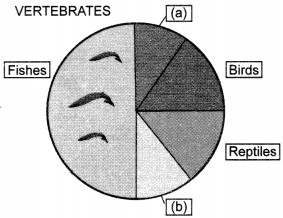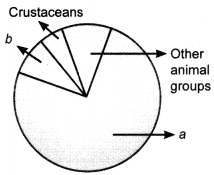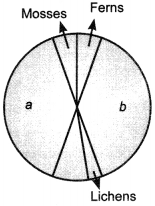Free PDF Download of CBSE Biology Multiple Choice Questions for Class 12 with Answers Chapter 15 Biodiversity and Conservation. Biology MCQs for Class 12 Chapter Wise with Answers PDF Download was Prepared Based on Latest Exam Pattern. Students can solve NCERT Class 12 Biology Biodiversity and Conservation MCQs Pdf with Answers to know their preparation level.
Biodiversity and Conservation Class 12 Biology MCQs Pdf
1. log S = log C + Z log A
In the given equation of species-area relationship, the value of regression coefficient for a whole continent, would be
(a) 0.1-0.2
(b) 0.5-0.7
(c) 0.6-1.2
(d) 0.3-0.5
Answer
Answer: c
2. Which of the following organisation is responsible for maintaining the Red Data Book?
(a) IDRI
(b) IUCN
(c) UNESCO
(d) USDA
Answer
Answer: b
3. From his long term ecosystem experiments, David Tilman showed that
(a) decreased diversity contributed to higher productivity
(b) decreased diversity contributed to decreased productivity
(c) increased diversity contributed to increased productivity
(d) increased diversity contributed to decreased productivity
Answer
Answer: c
4. Which of the following is a hot-spot of biodiversity in India?
(a) Western Ghats
(b) Indo-gangetic plain
(c) Eastern Ghats
(d) Aravalli Hills
Answer
Answer: a
5. Which among the following is not a method of in-situ conservation?
(a) National Park
(b) Botanical garden
(c) Wildlife sanctuary
(d) Ramsar sites
Answer
Answer: b
6. The World Summit on Sustainable Development (2002) was held in
(a) Brazil
(b) South Africa
(c) Sweden
(d) Argentina
Answer
Answer: b
7. The most important cause of extinction of animals and plants, especially in tropical rain forests is
(a) habitat loss
(b) afforestation
(c) pollution
(d) soil erosion
Answer
Answer: a
8. The enormous number of varieties of mango in India represents
(a) genetic diversity
(b) species diversity 1
(c) ecological diversity
(d) hybridisation programmes
Answer
Answer: a
9. Which one of the following is not a major characteristic feature of biodiversity hot spots? [NCERT Exemplar]
(a) Large number of species
(b) Abundance of endemic species
(c) Large number of exotic species
(d) Destruction of habitat
Answer
Answer: d
10. Which of the following is not a cause for loss of biodiversity? [NCERT Exemplar]
(a) Destruction of habitat
(b) Invasion by alien species
(c) Keeping animals in zoological parks
(d) Over-exploitation of natural resources
Answer
Answer: c
11. The extinction of passenger pigeon was due to [NCERT Exemplar]
(a) increased number of predatory birds.
(b) over exploitation by humans.
(c) non-availability of the food.
(d) bird flu virus infection.
Answer
Answer: b
12. Which of the below mentioned regions exhibit less seasonal variations? [NCERT Exemplar]
(a) Tropics
(b) Temperates
(c) Alpines
(d) Both (a) & (b)
Answer
Answer: a
13. India now has _____ wildlife sanctuaries.
Answer/Explanation
Answer:
Explaination: 448
14. 70 per cent of the animal species recorded are _____ .
Answer/Explanation
Answer:
Explaination: Insects.
15. ________ places the global species biodiversity at about 7 million.
Answer/Explanation
Answer:
Explaination: Robert May.
16. The maximum diversity of amphibians in India is observed in _____ .
Answer/Explanation
Answer:
Explaination: Western Ghat.
17. The recent introduction of Clarias gariepinus is posing threat to our indigenous _____ in our rivers.
Answer/Explanation
Answer:
Explaination: Catfishes.
18. _____ introduced into Lake Victoria caused extinction of 200 species of cichlid fishes.
Answer/Explanation
Answer:
Explaination: Nile perch.
19. Thylacine from _____ and quagga from Africa are examples of recent extinctions.
Answer/Explanation
Answer:
Explaination: Australia.
20. _____ popularised the term Biodiversity.
Answer/Explanation
Answer:
Explaination: Edward Wilson.
21. India’s share of global biodiversity is about _____ per cent.
Answer/Explanation
Answer:
Explaination: 8.1
22. _____, the last refuges of a number of threatened species of plants, are found in Aravalli Hills of Rajasthan and Jaintia Hills of Meghalaya.
Answer/Explanation
Answer:
Explaination: Sacred groves.
23. Match the items in Column I with those in Column II.
| Column I | Column II |
| A. Cryopreser-vation | 1. Hotspot |
| B. Tropical forests | 2. In situ conservation |
| C. Endemism | 3. Ex situ conservation |
| D. Lantana | 4. Coevolution |
| E. Plant-pollinator mutualifls | 5. Habitat loss |
| F. Wildlife sanctuary | 6. Alien species |
| 7. Stellar’s Sea cow |
Answer/Explanation
Answer:
Explaination: A – 3, B – 5, C – 1, D – 6, E – 4, F – 2
24. Match the items in Column I with those in Column II.
| Column I | Column II |
| A. Narrowly utilitarian | 1. Passenger pigeon |
| B. Broadly utilitarian | 2. Tannins, Resins of plants |
| C. The Earth Summit | 3. Pollination of plants |
| D. Over- exploitation | 4. Rio de Janeiro, in 1992 |
| 5. Ethical Arguments |
Answer/Explanation
Answer:
Explaination: A – 2, B – 3, C – 4, D – 1
25. Parthenium is an endemic species of our country. [True/False]
Answer/Explanation
Answer:
Explaination: False.
26. Stellar’s sea cow is an extinct animal. [True/False]
Answer/Explanation
Answer:
Explaination: True.
27. India is one of the mega diversity countries of the world. [True/False]
Answer/Explanation
Answer:
Explaination: True.
28. 20 per cent of the total oxygen in the earth’s atmosphere is produced by temperate forests like Amazon forest. [True/False]
Answer/Explanation
Answer:
Explaination: True.
29. Endemic species are those which are distributed in almost all parts on the globe. [True/False]
Answer/Explanation
Answer:
Explaination: False.
Directions (Q30 to Q33): Mark the odd one in each of the following groups.
30. Parthenium, Mangifera, Lantana Eichhornia
Answer/Explanation
Answer:
Explaination: Mangifera.
31. Bali, Javan, Caspian, Dodo
Answer/Explanation
Answer:
Explaination: Dodo.
32. Seed banks, Tissue culture, Sacred groves, Cryopreservation
Answer/Explanation
Answer:
Explaination: Sacred groves.
33. Aravalli Hills, Chanda and Bastar, Khasi Hills, Zoological park
Answer/Explanation
Answer:
Explaination: Zoological park.
34. Name the type of biodiversity represented by the following:
(a) 50,000 different strains of rice in India.
(b) Estuaries and alpine meadows in India. [Delhi 2013]
Or
India has more than 50,000 strains of rice. Mention the level of biodiversity it represents. [AI2010]
Answer/Explanation
Answer:
Explaination:
(a) Genetic diversity.
(b) Ecological diversity.
35. Name the type of biodiversity represented by the following:
(a) 1000 varieties of mango in India.
(b) Variations in terms of potency and concentration of reserpine in Rauwolfia vomitoria growing in different regions of Himalayas. [AI 2013]
Answer/Explanation
Answer:
Explaination:
(a) Genetic diversity
(b) Genetic diversity
36. Write the level of biodiversity represented by a mangrove. Give another example falling in the same level. [AI 2014C]
Answer/Explanation
Answer:
Explaination:
– Ecological diversity.
– Coral reefs/wet lands/estuaries/alpine meadows.
37. Why is genetic variation important in the plant Rauwolfia?
Answer/Explanation
Answer:
Explaination: Genetic variation in Rauwolfia is shown in terms of potency and concentration of the active chemical, reserpine produced by the plant.
38. Why is India said to have greater ecosystem diversity than Norway? [Delhi 2012C]
Answer/Explanation
Answer:
Explaination: India has much of its land in the tropical latitudes and has a number of ecosystems like deserts, mangroves, rain forests, coral reefs, wetlands and estuaries; hence, it has greater ecosystem diversity whereas Norway is located in the temperate latitudes and hence, shows less diversity.
39. Define species diversity..
Answer/Explanation
Answer:
Explaination: The diversity at the species level (types and numbers), is called species diversity.
40. Which region in India has the maximum number of amphibian species?
Answer/Explanation
Answer:
Explaination: Western Ghats.
41. Identify ‘a’ and ‘b’ in the figure given below representing proportionate number of major vertebrate taxa. [Delhi 2014]

Answer/Explanation
Answer:
Explaination:
‘a’ – Mammals,
‘b’ – Amphibians.
42. Name the unlabelled areas ‘a’ and ‘b’ of the pie chart (given) representing the global biodiversity of invertebrates showing their proportionate number of species of major taxa.

Answer/Explanation
Answer:
Explaination:
‘a’ – Insects;
‘b’ – Molluscs.
43. Name the unlabelled areas ‘a’ and ‘b’ of the pie chart representing the biodiversity of plants showing their proportionate number of species of major taxa.

Answer/Explanation
Answer:
Explaination:
‘a’ – Fungi,
‘b’ – Angiosperms.
44. Which region of the earth has the greatest biodiversity on earth?
Answer/Explanation
Answer:
Explaination: Amazonian rain forest.
45. What is the general range of the value of slope of the line of regression for any taxa in any region?
Answer/Explanation
Answer:
Explaination: 0.1 to 0.2.
46. Name one animal species that has become ‘extinct recently each in
(a) Australia and
(b) Mauritius, respectively.
Answer/Explanation
Answer:
Explaination:
(a) Thylacine.
(b) Dodo.
47. What per cent of the earth’s surface was covered by tropical rain forests at
(a) the beginning of 20th century and
(b) now, respectively?
Answer/Explanation
Answer:
Explaination:
(a) 14%
(b) 6%.
48. The Amazon rain forest is referred to as ‘the lungs of the planet’. Mention any one human activity which causes loss of biodiversity in this region. [AI 2010C]
Answer/Explanation
Answer:
Explaination:
(i) Many plants are cut and the land is cleared for cultivation of soyabean.
(ii) Conversion of forest land into grassland for raising beef cattle. (any one)
49. What is the main reason for the extinction of passenger pigeon?
Answer/Explanation
Answer:
Explaination: Over exploitation by humans.
50. What is common about Eichhornia, Lantana and Parthenium with reference to threat to our biodiversity?
Answer/Explanation
Answer:
Explaination: They are exotic species, introduced into India; these alien species have caused environmental damage and posed threat to our native species.
51. About 200 species of Cichlid fish became extinct when a particular fish was introduced in lake Victoria of Africa. Name the invasive fish.
Answer/Explanation
Answer:
Explaination: The Nile perch.
52. What is meant by threatened species?
Answer/Explanation
Answer:
Explaination: Threatened species are those organisms facing a very high risk of extinction in the wild in the near future.
53. What is the total number of hot spots in the world? How many of them are there in India?
Answer/Explanation
Answer:
Explaination:
– There are 34 hot spots in the world.
– Three are in India.
54. When was Ramsar Convention developed and adopted and when did it come into force?
Answer/Explanation
Answer:
Explaination: It was developed in 1971 and came into force from December, 1975.
55. What is the mission of Ramsar Convention?
Answer/Explanation
Answer:
Explaination: The mission of Ramsar convention is the conservation and wise use of wetlands through local and national actions and international cooperation and achieve sustainable development of wetlands throughout the globe.
56. Name the country that has the
(a) highest number of Ramsar sites
(b) greatest area of listed wetlands in the world, as on November 2013.
Answer/Explanation
Answer:
Explaination:
(a) England
(b) Canada
57. How many national parks and wildlife sanctuaries are there in India?
Answer/Explanation
Answer:
Explaination:
90 national parks and 448 wildlife sanctuaries are there in India.
58. Why have Western Ghats in India been declared as biological hot spots? [AI 2015C]
Answer/Explanation
Answer:
Explaination: It is because this region has a very high level of species richness and endemism.
59. Name any two conventional methods of ex situ conservation.
Answer/Explanation
Answer:
Explaination: Botanical gardens, wildlife safaris and zoos are the conventional ex situ strategies. (any two)
60. Write the importance of cryopreservation in conservation of biodiversity. [Delhi 2011]
Answer/Explanation
Answer:
Explaination: It is an ex situ method of biodiversity conservation in which gametes of threatened species can be preserved in viable and fertile conditions for long periods.
We hope the given Biology MCQs for Class 12 with Answers Chapter 15 Biodiversity and Conservation will help you. If you have any query regarding CBSE Class 12 Biology Biodiversity and Conservation MCQs Pdf, drop a comment below and we will get back to you at the earliest.